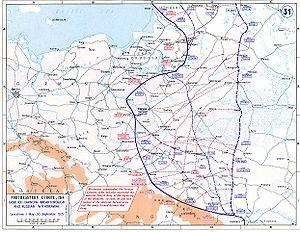
Back Свянцянскі прарыў Byelorussian Віленская апэрацыя BE-X-OLD Schlacht bei Wilna German Offensive de Sventiany French Offensiva di Sventiany Italian Švenčionysoffensief Dutch Виленская операция Russian Вильно операциясе Tatar Віленська операція Ukrainian Chiến dịch tấn công Švenčionys Vietnamese
| Vilno-Dvinsk offensive | |||||||
|---|---|---|---|---|---|---|---|
| Part of the Eastern Front of World War I | |||||||
 Russian withdrawal in 1915. | |||||||
| |||||||
| Belligerents | |||||||
|
|
| ||||||
| Commanders and leaders | |||||||
| Units involved | |||||||
| Strength | |||||||
| Casualties and losses | |||||||
The Vilno-Dvinsk offensive took place in the autumn of 1915 between the cities of Vilno (present-day Vilnius[b]) and Dvinsk (present-day Daugavpils[c]). It was strategic withdrawal by Russian forces on the Eastern Front of World War I, after a successful summer German offensive. The German armies were under the command of Supreme Commander of All German Forces in the East, Field Marshal Paul von Hindenburg. Although weakened by the transfer of 12 divisions to France and the Balkans, as part of taking a defense, Hindenburg had his forces conduct several secondary offensive operations. However, the numerical superiority of the Russians did not allow Hindenburg to achieve a lasting success. Further actions for the Germans were extremely unsuccessful, here they suffered heavy losses and did not achieve their goal - to take Dvinsk[3][1]
- ^ a b Олейников 2016, p. 133-135.
- ^ Олейников 2016, p. 133.
- ^ a b Борисюк 2023, p. 90.
- ^ a b c Deutsches Reich. Heeres-Sanitätsinspektion 1935, Table 11.
- ^ Нелипович 2022, pp. 706–709.
- ^ Нелипович 2022, p. 715.
- ^ a b c Нелипович 2022, p. 718.
Cite error: There are <ref group=lower-alpha> tags or {{efn}} templates on this page, but the references will not show without a {{reflist|group=lower-alpha}} template or {{notelist}} template (see the help page).
© MMXXIII Rich X Search. We shall prevail. All rights reserved. Rich X Search